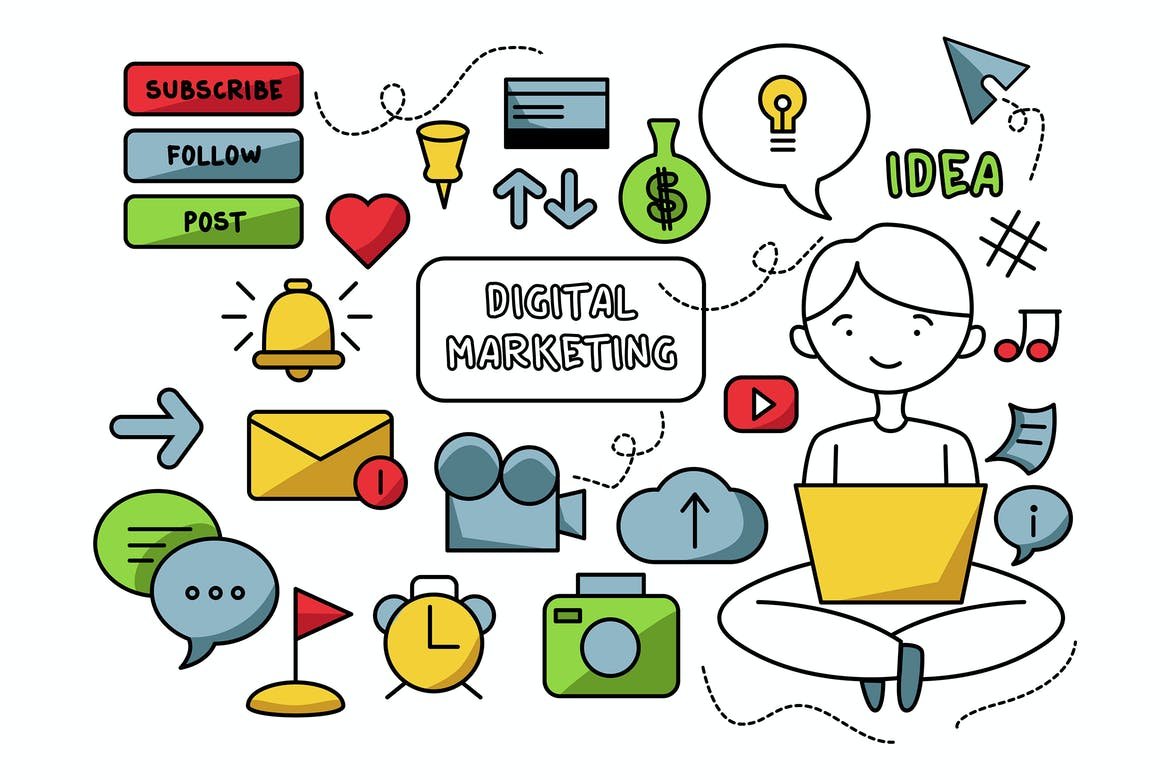If you want to grow your business, then digital marketing is a must. It’s the new way of promoting and selling products and services. With the emergence of social media, online advertising has become even more crucial to success in today’s world. However, it can be challenging to precisely determine what steps are necessary for an effective digital marketing strategy.
That’s why we’ve put together this blog post on how to build your digital market plan! This will help you get started with all that you need for a successful campaign.
To create an effective Digital Marketing Strategy, start by defining who or what your target audience will be. For example, if you’re looking at children’s toys, you might want to look at a younger audience. Who is the target audience going to be? This will help you define where you want your ads to appear on social media and how much money you will spend on advertising.
1. Understand the importance of digital marketing.
When it comes to marketing your business, understanding the importance of digital marketing is vital. It’s no longer just an optional extra that you can choose to use or not; it’s now become a part of promoting and selling products and services. Digital advertising has grown significantly in recent years, with social media benefiting greatly from this increase.
With the introduction of social media, the world has become a much smaller place. Digital marketing allows you to promote and sell products and services to anyone, anywhere in the world. With Facebook and Twitter having so many users, this is excellent news for small businesses or new companies looking to break into an already established market.
2. Create a social media strategy
Before you can start promoting your business on any social media platform, you first need to create a strategy for it. Think about what works best within the market that you’re trying to break into; focus on how many potential customers might be on each site, and think about where your target audience will be. You also need to consider what your competitors may be doing and try to stand out from the crowd.
For example, if you’re looking at children’s toys, you might want to look at a younger audience, who may already be on Facebook or Instagram. Make sure that you know what success would look like for your company before taking any steps toward advertising on social media.
3. Identify your target audience and customer personas
Once you have a digital strategy in place, it’s time to identify your target audience and customer personas. Who is your target audience going to be? Why do they use social media sites? What are their needs? This will help you define where you want your ads to appear on social media and how much money you will spend on advertising.
It’s also helpful to know who your customer personas are. These are different types of people within your target audience, which you may need to speak to when creating ads. It might be that certain groups will understand your product or service easily; in this case, it would make sense for them to see your ads. Knowing your target audience and customer personas will help you to create compelling social media strategies.
4. Determine your content goals for each channel
Once you understand who your target audience is, it’s time to start with the actual social media marketing. What do you want people to do when they see your ads? Do you want them to visit your website and sign up for newsletters? Or maybe purchase on your site? Every social media channel works differently; it’s essential to understand how they do this.
When you create an ad, make sure that your content is relevant and reflects the business you’re promoting. Also, make sure that your image is professional and attention-grabbing. With so many ads being created every day, you must stand out from the crowd.
Once you know what content you want people to interact with, the next step is to find out where they are on social media. You can determine this by using tools such as Google Analytics; once you know which site will work best for your business, continue using it every day.

Related Post: Digital agency services
5. Build an editorial calendar to stay on top of things
When you decide on the best social media sites, it’s time to start using them daily. It can be challenging to keep up with everything at first, which is why it’s essential to create an editorial calendar. This will allow you to see what content you have planned for the week or month in advance, ensuring that your posts are more effective.
It’s also helpful to know how often you should post on social media. According to Buffer, some of the best times for posting on each site are early morning on weekdays; however, your posts will be seen more if you spread them throughout the day. You’ll need to find out what works best for your business and then stick to it.
An editorial calendar will also allow you to schedule posts in advance, giving them a boost of exposure on social media. Make sure you post interesting content that encourages people to interact with your brand. Don’t forget about emojis or hashtags, either. It’s easy for your branding to become diluted if you don’t use these; your content will become less engaging and be ignored by people.
6. Outline all the different types of content you’ll need to create, including blog posts, videos, infographics, etc., and how often they should be published or updated
Once you’ve created an editorial calendar, it’s time to start creating content. You’ll need to consider several different types; blog posts, videos, infographics, and more. Your content must be fresh and exciting, or people will lose interest quickly. You’ll also need to plan how often the content should be updated; if you post too often, your subscribers may see it as spam and ignore you. If you don’t post often enough, people won’t be reminded about your business or why they should interact with it. It’s a balancing act, but one that can help you to create compelling social media strategies for businesses of all sizes.
Social media is a great way to interact with customers and potential clients. It’s also an easy way for people to find out more information about your business or brand and promote products or services that you have on offer. However, when it comes to social media marketing, there are some mistakes that businesses of all sizes tend to make. Some of the most common include:
- Not posting enough content.
- Ignoring conversations that happen on social media, such as complaints or questions from customers
- Use too many hashtags, including those that aren’t relevant to your business.
- Posting only promotional material and not enough about your business or brand
- Not using images in posts and overusing graphics that aren’t engaging enough.
- Spamming people with links to your content without adding any value
- Using too many platforms or not sticking to one specific site.
- Scheduling everything and not interacting regularly
- Focusing on organic reach rather than paid content.
- Tagging people without asking for permission first, making them feel uncomfortable about the interaction
If you keep these common mistakes in mind, creating a social media strategy that works well for your business or brand will be easier. With some extra time and effort, you’ll be able to create a solid strategy that brings people back to your site and helps you grow.
7. Evaluate analytics regularly to track progress and make adjustments as needed
It’s essential to track your social media analytics closely to know which content is performing well and what needs to be improved. If you have a blog, for example, it can be beneficial to look at your visitor statistics regularly to know where people are coming from. This will allow you to plan new posts around the types of readers that are visiting your site. If you don’t have a blog, you’ll still need to do the same with your social media channels by checking out which links or content has been performing well so that you can plan more of it. You may also want to look into Facebook Insights and Twitter Analytics; these tools will give you a better idea of how people interact with your brand.
By keeping track of analytics, you’ll be able to spot trends quickly so that you can identify what works and what doesn’t for your brand or business. You’ll also learn more about the type of content your target audience prefers, which is always beneficial when creating new content for social media.
If you’re considering getting into social media marketing, it’s essential to understand what needs to be done to get the most out of your campaign. For many companies, this means hiring an expert who can create a solid strategy and help them get more out of their efforts. This is usually the best option for larger companies, but small businesses can do the same with some extra time and effort. In the end, it’s usually a good idea to learn as much as possible about social media marketing and try to create a strategy that works well for your business or brand.
An expert can help you plan out content, regularly interact with customers, schedule posts and monitor analytics so that you can see how your campaign is performing at all times. Social media is a crucial way to market your business, so it’s always a good idea to ensure you’re doing things the right way to get more out of your efforts.
Growth Hacking can be used in any field where there are users who want something (e.g., information, contacts, physical products, etc.) and organizations who could provide it. So, this means that Growth Hacking could be used in any market and almost always by a startup.
“Growth hacking” is a buzzword for the moment, and it has been defined in many different ways:
– The definition given by Andrew Chen (a very influential Growth Hacker) is “A growth hacker is a person whose true north is growth. Its potential impact on scalable growth scrutinizes everything they do.” – Another definition could come from Neil Patel, who defines a Growth Hacker as “a person whose true north is growth; she lives and breathes it 24/7”
– Sean Ellis (the creator of the term Growth Hacking) has said that “Growth hacking is a mindset” and that “Growth hackers are analytical, technical and entrepreneurial. They see their job as to build sustainable growth into their products.”
– Sean Ellis also says that “A Growth Hacker is a person whose true north is growth who will work with marketing, product management, analytics/data science, engineering (especially frontend), design, and other key teams to identify weaknesses in a business model and work backward to fix them”
– Finally, Andrew Chen says, “Growth hackers are marketers with an engineering mindset – they’re hybrids. They understand the product better than any marketer, they care about the technical details more than most engineers, and they can think strategically just as well as the best marketers.”
So, Growth Hackers think like entrepreneurs, have an analytical mindset, and do anything they can to grow their business. They’re also influential because they know how to reach “viral growth,” which means that the product or service they provide spreads fast through word of mouth.

